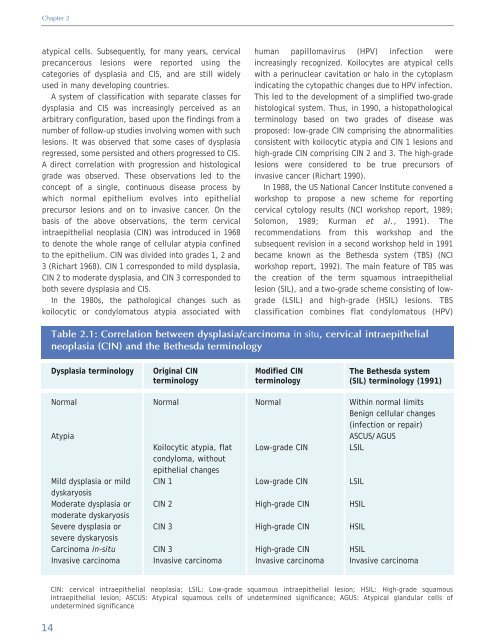Colposcopy and Treatment of Cervical Intraepithelial Neoplasia - RHO
Colposcopy and Treatment of Cervical Intraepithelial Neoplasia - RHO
Colposcopy and Treatment of Cervical Intraepithelial Neoplasia - RHO
Create successful ePaper yourself
Turn your PDF publications into a flip-book with our unique Google optimized e-Paper software.
Chapter 2<br />
atypical cells. Subsequently, for many years, cervical<br />
precancerous lesions were reported using the<br />
categories <strong>of</strong> dysplasia <strong>and</strong> CIS, <strong>and</strong> are still widely<br />
used in many developing countries.<br />
A system <strong>of</strong> classification with separate classes for<br />
dysplasia <strong>and</strong> CIS was increasingly perceived as an<br />
arbitrary configuration, based upon the findings from a<br />
number <strong>of</strong> follow-up studies involving women with such<br />
lesions. It was observed that some cases <strong>of</strong> dysplasia<br />
regressed, some persisted <strong>and</strong> others progressed to CIS.<br />
A direct correlation with progression <strong>and</strong> histological<br />
grade was observed. These observations led to the<br />
concept <strong>of</strong> a single, continuous disease process by<br />
which normal epithelium evolves into epithelial<br />
precursor lesions <strong>and</strong> on to invasive cancer. On the<br />
basis <strong>of</strong> the above observations, the term cervical<br />
intraepithelial neoplasia (CIN) was introduced in 1968<br />
to denote the whole range <strong>of</strong> cellular atypia confined<br />
to the epithelium. CIN was divided into grades 1, 2 <strong>and</strong><br />
3 (Richart 1968). CIN 1 corresponded to mild dysplasia,<br />
CIN 2 to moderate dysplasia, <strong>and</strong> CIN 3 corresponded to<br />
both severe dysplasia <strong>and</strong> CIS.<br />
In the 1980s, the pathological changes such as<br />
koilocytic or condylomatous atypia associated with<br />
human papillomavirus (HPV) infection were<br />
increasingly recognized. Koilocytes are atypical cells<br />
with a perinuclear cavitation or halo in the cytoplasm<br />
indicating the cytopathic changes due to HPV infection.<br />
This led to the development <strong>of</strong> a simplified two-grade<br />
histological system. Thus, in 1990, a histopathological<br />
terminology based on two grades <strong>of</strong> disease was<br />
proposed: low-grade CIN comprising the abnormalities<br />
consistent with koilocytic atypia <strong>and</strong> CIN 1 lesions <strong>and</strong><br />
high-grade CIN comprising CIN 2 <strong>and</strong> 3. The high-grade<br />
lesions were considered to be true precursors <strong>of</strong><br />
invasive cancer (Richart 1990).<br />
In 1988, the US National Cancer Institute convened a<br />
workshop to propose a new scheme for reporting<br />
cervical cytology results (NCI workshop report, 1989;<br />
Solomon, 1989; Kurman et al., 1991). The<br />
recommendations from this workshop <strong>and</strong> the<br />
subsequent revision in a second workshop held in 1991<br />
became known as the Bethesda system (TBS) (NCI<br />
workshop report, 1992). The main feature <strong>of</strong> TBS was<br />
the creation <strong>of</strong> the term squamous intraepithelial<br />
lesion (SIL), <strong>and</strong> a two-grade scheme consisting <strong>of</strong> lowgrade<br />
(LSIL) <strong>and</strong> high-grade (HSIL) lesions. TBS<br />
classification combines flat condylomatous (HPV)<br />
Table 2.1: Correlation between dysplasia/carcinoma in situ, cervical intraepithelial<br />
neoplasia (CIN) <strong>and</strong> the Bethesda terminology<br />
Dysplasia terminology<br />
Original CIN<br />
terminology<br />
Modified CIN<br />
terminology<br />
The Bethesda system<br />
(SIL) terminology (1991)<br />
Normal<br />
Atypia<br />
Mild dysplasia or mild<br />
dyskaryosis<br />
Moderate dysplasia or<br />
moderate dyskaryosis<br />
Severe dysplasia or<br />
severe dyskaryosis<br />
Carcinoma in-situ<br />
Invasive carcinoma<br />
Normal<br />
Koilocytic atypia, flat<br />
condyloma, without<br />
epithelial changes<br />
CIN 1<br />
CIN 2<br />
CIN 3<br />
CIN 3<br />
Invasive carcinoma<br />
Normal<br />
Low-grade CIN<br />
Low-grade CIN<br />
High-grade CIN<br />
High-grade CIN<br />
High-grade CIN<br />
Invasive carcinoma<br />
Within normal limits<br />
Benign cellular changes<br />
(infection or repair)<br />
ASCUS/AGUS<br />
LSIL<br />
LSIL<br />
HSIL<br />
HSIL<br />
HSIL<br />
Invasive carcinoma<br />
CIN: cervical intraepithelial neoplasia; LSIL: Low-grade squamous intraepithelial lesion; HSIL: High-grade squamous<br />
intraepithelial lesion; ASCUS: Atypical squamous cells <strong>of</strong> undetermined significance; AGUS: Atypical gl<strong>and</strong>ular cells <strong>of</strong><br />
undetermined significance<br />
14
















